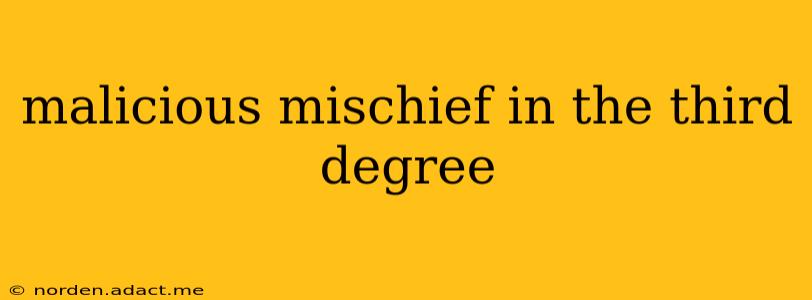Malicious mischief, a crime often misunderstood, encompasses a range of actions involving the intentional damage or destruction of property. This guide focuses on malicious mischief in the third degree, exploring its definition, penalties, and related legal considerations. Understanding this crime is crucial for both legal professionals and citizens alike.
What Constitutes Malicious Mischief in the Third Degree?
Malicious mischief in the third degree typically involves the intentional damage or destruction of property, but the specifics vary depending on the jurisdiction. Generally, it's a misdemeanor offense, meaning it's less severe than a felony. Key elements usually include:
- Intentional Act: The damage must be intentional, not accidental. Recklessness, while sometimes a factor in other crimes, may not be sufficient for a third-degree charge. The prosecution must prove the accused acted with a specific intent to damage the property.
- Damage to Property: The property damaged must belong to another person. Damaging your own property wouldn't constitute malicious mischief. The extent of the damage is also relevant; typically, third-degree charges involve less significant damage than higher-degree offenses. The value of the damage often plays a role in determining the severity of the charge.
- No Specific Intent to Defraud: This distinguishes malicious mischief from other crimes like theft or fraud. The focus is solely on the damage to the property, not any financial gain from that damage.
What are the Penalties for Malicious Mischief in the Third Degree?
Penalties for malicious mischief in the third degree vary significantly by state and even by specific circumstances within a state. These can include:
- Fines: Monetary penalties are common, the amount of which often correlates with the extent of the damage caused.
- Jail Time: While often not substantial, jail time is a possibility, especially for repeat offenders or cases involving significant damage.
- Probation: This is a common sentence, allowing the offender to remain in the community under supervision. Conditions of probation can vary greatly.
- Restitution: The offender may be ordered to pay restitution to the victim for the cost of repairing or replacing the damaged property. This is frequently mandated alongside other penalties.
It's crucial to consult the specific statutes in your jurisdiction to determine the precise penalties for this crime.
What is the difference between malicious mischief and vandalism?
While often used interchangeably, malicious mischief and vandalism aren't always legally synonymous. Vandalism is generally a broader term encompassing intentional destruction of property, often with an element of public display or defiance. Malicious mischief, as a legal term, often has more precise elements and defined penalties as detailed above. In some jurisdictions, vandalism might be a specific charge under malicious mischief statutes, while in others, they are treated as distinct offenses.
What if the damage is minor? Will it still be considered a crime?
Even minor damage can be grounds for a malicious mischief charge, depending on the jurisdiction and the specific circumstances. The prosecution must still prove the intent to damage the property, but the threshold for the extent of damage needed to constitute a crime can be surprisingly low. This emphasizes the importance of understanding the specific laws in your area.
Can I be charged with malicious mischief if I accidentally damaged someone's property?
No. A key element of malicious mischief is intent. If the damage was purely accidental, without any intent to harm or damage the property, then a charge of malicious mischief is unlikely. However, proving the lack of intent might require demonstrating the accident's circumstances.
What defenses might be available in a malicious mischief case?
Several defenses could be employed in a malicious mischief case, including:
- Lack of Intent: Arguing that the damage was accidental or unintentional.
- Self-Defense: If the damage was done in self-defense or to protect property from immediate harm. This defense is rarely successful in simple malicious mischief cases.
- Consent: If the property owner consented to the actions that caused the damage.
This information is for educational purposes only and should not be considered legal advice. If you face charges of malicious mischief or have questions about this crime, it's crucial to consult with a qualified legal professional in your jurisdiction. They can advise you on the specific laws and potential outcomes in your situation.
